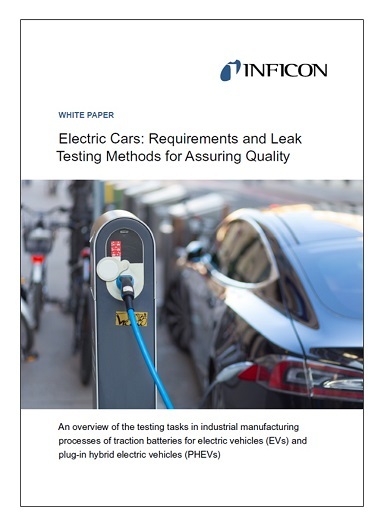From Tech Crawl 2018 - Keep Your Batteries DRY
 |
INFICON tracer gas testing.
By Steve Purdy
The Auto Channel
Michigan Bureau
Unlike a pub-crawl, the annual tech and business forum we know as Tech Crawl, hosted by AutoCom Associates in Detroit, fills an afternoon and does not involve a headache the next morning – at least for most of us. We reporters attend to add to our knowledge of technology, and its effect on both automobiles and society presented by a variety of auto industry suppliers. We learn about advances in lighting, paints and chemicals, pre-assembled front ends, new brake technology, electrification and electric motors for automobiles and more. A few highlights stand out from this year’s forum.
 |
Thomas Parker, INFICON’s North American automotive sales manager, offered an in-depth description of an issue that strikes home with what we’re hearing daily from Tesla, Ford’s Edison electrification project, GM’s Bolt and more EV projects. “The market for electric vehicles (EVs) is booming,” said Parker. “But to maintain a positive reputation for EVs, it is critically important for automakers to not only offer extended driving ranges and short charging times, but safe, high-quality drive technology as well. Leak testing is key to achieving quality throughout the production process from battery cell manufacture to vehicle assembly.” Or, stated simply, every customer wants a reliable, durable, quality vehicle.
Leak testing has routinely been performed by dunking parts and assemblies into tanks of water, and then waiting for bubbles to rise. This can be problematic as water and batteries do not play well together. Second, batteries need to be as resistant to leakage from atmospheric water vapor as a pacemaker. Third, the permissible leak rate would be one bubble per hour! Remember, we’re talking about what the industry calls “traction batteries,” those that propel your vehicle, not the less-sophisticated, black 12-Volt box under most hoods today.
There are many reasons traction batteries need to be leak-tight. “Few consumers are prepared to spend significant amounts of money to replace a traction battery after a few years of use. And they definitely do not want their vehicle to catch fire,” Parker says.
Fire? Why, yes. That can happen with these batteries.
Just as air bag inflators have suffered catastrophic, highly visible failures because of leakage, so can lithium-ion traction batteries. Their chemistry is dangerously altered by water—even one drop. “Auto manufacturers and suppliers need to incorporate suitable leak-detection processes into their production operations, to avoid disasters,” the INFICON executive explains. “Battery-cell electrolytes must never be allowed to escape or come into contact with water or humidity. That sort of leak can create a ‘thermal runaway’ and cause an explosion or a fire that can reach up to 1,100 degrees Centigrade (2,000 degrees Fahrenheit).”
Parker offered those attending a white paper on battery leak testing. Here are the high points:
Test individual battery cells for “tightness” – Battery cells must be completely air and water tight to avoid thermal incidents that could cause a fire or an explosion.
Avoid “thermal runaway” during transportation – A single battery cell with an internal short circuit or leak can potentially cause a shipping container to explode.
Require leak-test receipts on incoming batteries – An efficient incoming-goods test is essential to help ensure that welds between the cover plate and the electrode contacts are fully sealed (prismatic cells), catch crimped connections between cylindrical housings and electrodes (round cells), and find any bag-seal leaks (pouch cells).
Check battery-module housings and packs for leaks – As battery cells are assembled into battery modules and packs, battery housings must be able to protect the modules and cells from water and conform to IP67 or IP69K protection ratings.
Assure battery cooling-system quality – Cooling system leaks can cause a traction battery to overheat and affect its reliability and service life. Heat can cause the breakdown of most chemical compounds, including lithium-ion batteries.
This means everyone in the automotive industry and supply chain must be scrupulous in testing. So, leak-tightness starts with building the cell container, then the assembled cell, then multiple cells gathered into a pack, and finally multiple packs assembled into a full-sized battery pack with testing at every step. We hadn’t thought, though it’s obvious, that batteries need to be cooled, often using water-based designs. There’s another place where testing needs to occur.
“Testing for component leaks that might allow water to come into contact with battery-cell electrolytes at any time during the production process is especially important,” Parker concluded. “Water is like Kryptonite for today’s EV battery.”
While I’m certainly not an engineer or tech guy, but I’m always interested to go behind the scenes to see what goes into the amazing level of quality and durability characterizing automobiles today. Mr. Parker does a great job explaining the complexity without overwhelming my limited tech capacity.
If this interests you, the entire white paper is available, free, from INFICON. “Electric Cars: Requirements and Leak Testing Methods for Assuring Quality”
© Steve Purdy, Shunpiker Productions, All Rights Reserved


